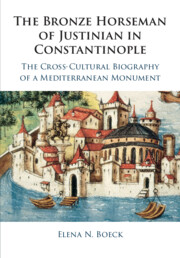 The Bronze Horseman of Justinian in Constantinople
The Bronze Horseman of Justinian in Constantinople Published online by Cambridge University Press: 08 April 2021
Before and after the fall of the Byzantine capital in 1453, Orthodox Slavic rulers imagined Constantinople as an ideal imperial capital and an icon of Orthodox empire. While the physical city was dramatically declining in the fourteenth and fifteenth centuries, it remained iconic. An imperial ideal was materialized in the ensemble of two architectural monuments – Hagia Sophia and the horseman. Hagia Sophia and the horseman were the interconnected memory sites of Constantinople. Their gigantic size and physical proximity united them as breathtaking manifestations of a sacralized Orthodox capital of a bygone age. Though this image was promoted by Palaiologan fundraising campaigns of the fourteenth century, it continued to flourish in Slavic lands long after Byzantium ceased to exist. By analyzing the illustrated history created for Ivan Alexander of Bulgaria in the mid-fourteenth century, the narratives of Russian pilgrims and church officials, and the Slavic version of the Narrative on the Construction of Hagia Sophia, I demonstrate how Slavic Orthodox rulers constructed an image of a timeless, sacred city. While for Ivan Alexander Constantinople was a political, historical place, for Russian observers Constantinople became a timeless, sacral entity.
To save this book to your Kindle, first ensure [email protected] is added to your Approved Personal Document E-mail List under your Personal Document Settings on the Manage Your Content and Devices page of your Amazon account. Then enter the ‘name’ part of your Kindle email address below. Find out more about saving to your Kindle.
Note you can select to save to either the @free.kindle.com or @kindle.com variations. ‘@free.kindle.com’ emails are free but can only be saved to your device when it is connected to wi-fi. ‘@kindle.com’ emails can be delivered even when you are not connected to wi-fi, but note that service fees apply.
Find out more about the Kindle Personal Document Service.
To save content items to your account, please confirm that you agree to abide by our usage policies. If this is the first time you use this feature, you will be asked to authorise Cambridge Core to connect with your account. Find out more about saving content to Dropbox.
To save content items to your account, please confirm that you agree to abide by our usage policies. If this is the first time you use this feature, you will be asked to authorise Cambridge Core to connect with your account. Find out more about saving content to Google Drive.